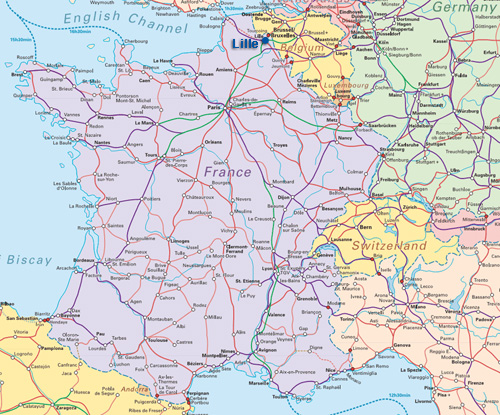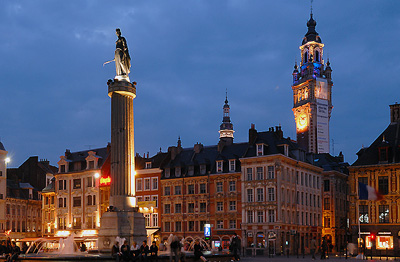|
• France
FRANCE (pop. 66 million) is a major industrialized nation, the third largest country in Europe (after Russia and Ukraine), and the fourth most populous. Officially called the French Republic (République Française), the nation includes ten overseas possessions, most of them remnants of France’s former colonial empire. Paris is the nation’s capital and largest city.
Roughly hexagonal in shape, France shares boundaries with Belgium and Luxembourg to the northeast; Germany, Switzerland, and Italy to the east; and Spain and Andorra to the southwest. In the northwest, France is bounded by the English Channel. At the Straights of Dover, the narrowest part of the channel, France and England are separated by just 34 km. France faces three major seas: the Atlantic Ocean to the west, the North Sea to the north, and the Mediterranean Sea to the southeast.
France is a nation of varied landscapes, ranging from coastal lowlands and broad plains in the north, to hilly uplands in south central France, to lush valleys and towering, snow-capped Alps in the east. Mountainous and hilly areas lie on nearly all of France’s borders, creating a series of natural boundaries for the country. Only the nation’s northeastern border is largely unprotected. Several major rivers drain France, including the Seine, Loire, Garonne, and Rhône.
The economy of France is large, diverse, and one of the most highly developed in the European Union (EU). It is a leading manufacturing nation, producing goods such as automobiles, electrical equipment, machine tools, and chemicals. France is the EU’s most important agricultural nation—shipping cereals, wine, cheese, and other agricultural products to the rest of Europe and the world. In recent decades service industries, including banking, retail and wholesale trade, communications, health care, and tourism, have come to dominate the French economy.
| |
 |
France is one of the oldest states in the Western world and its history is rich and varied. Little is known of France’s earliest inhabitants. Cave paintings in southwestern France dated to about 15,000 BC reveal the existence of a sophisticated and creative people. By the 8th century BC hordes of Celts, among other tribes, began entering and settling in France. A Celtic word, Gaul, was a name used in antiquity for the region of France. The ancient Romans incorporated France in the 1st century BC and ruled the region until the Roman Empire collapsed in the 5th century AD. After the fall of Rome, a series of royal dynasties ruled much of what would become France. Royal power declined in the Middle Ages with the spread of feudalism, which distributed power among local rulers. From the 14th to 18th century the power of the monarchy grew steadily as French kings and their ministers built a centralized bureaucracy and a large standing army. The French Revolution in 1789 toppled the monarchy, ushering in decades of political instability. Despite this turmoil, the revolution, and the subsequent rule of Napoleon Bonaparte, established a uniform administrative state in France.
French strength and prosperity grew during the 19th and early 20th centuries, and France built a worldwide colonial empire rivaling that of the United Kingdom. Much of World War I (1914-1918) was fought on French soil, and the nation suffered heavy losses. During World War II (1939-1945), Germany occupied northern France while a collaborationist regime was established at Vichy in central France. After the war France rebuilt its shattered economy and emerged as one of the world’s major industrial countries. Growing resistance to French rule in the colonies increased in the postwar period, triggering a wave of decolonization that stripped France of most of its overseas possessions. A new constitution was approved that strengthened the powers of the presidency, and General Charles de Gaulle, a war resistance leader, became the new government’s first president. De Gaulle viewed France as a great power, and he followed an independent stance in foreign affairs, a policy that helped boost France’s international influence. In recent decades, France, working closely with Germany, has played a leading role in the move toward greater European economic and political integration through the European Union.
• Lille
LILLE is a city in northern France (French Flanders). It is the principal city of Lille Métropole, the fourth-largest metropolitan area in the country behind those of Paris, Lyon and Marseille. Lille is situated on the Deûle River, near France's border with Belgium. It is the capital of the Nord-Pas de Calais region. Metropolitan Lille is inhabited by more than 1 million people.
The name Lille comes from insula or l'Isla, i.e., 'the island', since the area was at one time marshy. This name was used for the castle of the Counts of Flanders, built on dry land in the middle of the marsh. From the 12th century, the fame of the Lille cloth fair began to grow. The 16th century was marked by the outbreak of the Plague, a boom in the regional textile industry, and the Protestant revolts. In 1667, Louis XIV of France (the Sun-King) successfully laid siege to Lille, resulting in it becoming French in 1668 under the Treaty of Aix-la-Chapelle; this provoked discontent among the citizens of the prosperous city. A number of important public works undertaken between 1667 and 1670, such as the Citadel, enabled the King to gradually gain the confidence of his Lille subjects, some of whom continued to feel Flemish, though they had always spoken the Romance Picard language.
From 1708 to 1713, the city was occupied by the Dutch, during the War of the Spanish Succession. Throughout the 18th century, Lille remained profoundly Catholic. It took little part in the French Revolution, though there were riots and the destruction of churches. At the beginning of the 19th century, Napoleon I's continental blockade against the United Kingdom led to Lille's textile industry developing itself even more fully. The city was known for its cotton, and the nearby towns of Roubaix and Tourcoing worked wool.
In the 20th century, Lille profited from the Industrial Revolution, particularly via coal and the steam engine. The entire region had grown wealthy thanks to the mines and to the textile industry. However, during World War I, a major part of Lille was burned down. In July 1921, at the Pasteur Institute in Lille, Albert Calmette and Camille Guérin discovered the first anti-tuberculosis vaccine, known as BCG. The Opéra de Lille, designed by Lille architect Louis M. Cordonnier, was dedicated in 1923. From 1931 Lille felt the repercussions of the Great Depression, and by 1935 a third of the city's population lived in poverty.
During the Battle of France, in World War II, Lille was besieged by German forces for several days. Due to the prolonged French defense, many Allied troops were able to escape to Dunkirk. When Belgium was invaded, the citizens of Lille, still marked by the events of World War I, began to flee the city in large numbers. Lille was part of the zone under control of the German commander in Brussels, and was never controlled by the Vichy government in France. Rationing came to an end in 1947, and by 1948, some normality had returned to Lille.
| |
 |
Throughout the 1960s and 70s, the region was faced with some problems after the decline of the coal, mining and textile industries. From the start of the 1980s, the city began to turn itself more towards the service sector. In 1983, the VAL, the world's first automated rapid transit underground network, was opened. In 1993, a high-speed TGV train line was opened, connecting Paris with Lille in one hour. This, with the opening of the Channel Tunnel in 1994 and the arrival of the Eurostar train, put Lille at the centre of a triangle connecting Paris, London and Brussels. Work on Euralille, an urban remodelling project, began in 1991. The Euralille Centre was opened in 1994, and the remodeled district is now full of parks and modern buildings containing offices, shops and apartments. In 1994 the "Grand Palais" was also opened and in 2004
Lille was elected European Capital of Culture, along with the Italian city of Genoa.
Lille features an array of architectural styles with various amounts of Flemish influence, including the use of brown and red brick. These architectural attributes, many uncommon in France, help make Lille a transition in France to neighboring Belgium, as well as nearby Netherlands and England. Points of interest include the Lille Cathedral (Basilique-cathédrale Notre-Dame-de-la-Treille), Citadel of Lille, Palais des Beaux-Arts de Lille, Jardin botanique de la Faculté de Pharmacie, Jardin botanique Nicolas Boulay, Jardin des Plantes de Lille, etc.
Notable people from Lille include: Louis Pasteur, (1822–1895), micro-biologist; Joseph Valentin Boussinesq (1842–1929), mathematician and physicist; Édouard Lalo (1823–1892), composer; Charles de Gaulle (1890–1970), general, resistance fighter, President of France; Pierre Mauroy (1928–), deputy, senator, Prime Minister of France, and Mayor of Lille.
• Venue
The World Bridge Games will be played in Lille's Grand Palais convention centre, a modern facility which offers ample space for all tournament operations.
The Grand Palais is a meeting place at the heart of a triangle of European capitals, Paris, London and Brussels. Designed by the Dutch architect Rem Koolhass (2000 Pritzker prize winner) and inaugurated in June 1994, Lille Grand Palais is an exceptional centre, unique in Europe, highly adaptable and housing many inter-communicating spaces under one roof: congress-convention-seminar, exhibitions and the Zenith Arena (concert hall).
With its 45,000 m2 surface area, Lille Grand Palais offers:
• 3 auditoriums (from 300 to 1,500 seats)
• 28 meeting rooms (from 20 to 400 seats)
• 1 Zenith Arena (4,500 seated / 7,000 standing)
Situated in the town centre, Lille Grand Palais is easily accessible whatever mode of transport is used. There are some 6,000 parking spaces (1,200 of them underground) under 10 min walking distance from Lille Grand Palais. Special access is provided for the disabled, and there is Wi-Fi Internet access throughout the centre.
• Hotels
IMSA has arranged special room rates for participants and accompanying guests in a variety of hotels throughout Lille. Click on the button to get the hotel list. Room reservations should be made contacting the hotel directly, as indicated.
|

